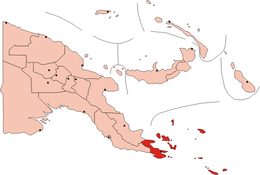Louisiade Archipelago
| Map of Papua New Guinea. The Louisiade Archipelago is in the dark red area at the bottom of the map | |
| Geography | |
|---|---|
| Coordinates | 11°12′S 153°00′E / 11.200°S 153.000°ECoordinates: 11°12′S 153°00′E / 11.200°S 153.000°E |
| Total islands | 300+ |
| Area | 1,871.1 km2 (722.4 sq mi) |
| Administration | |
| Province | Milne Bay Province |
| Capital city | Bwagaoia |
| Largest settlement | Bwagaoia (pop. 2680) |
| Demographics | |
| Population | 47000 (2014) |
The Louisiade Archipelago is a string of ten larger volcanic islands frequently fringed by coral reefs, and 90 smaller coral islands located 200 km southeast of New Guinea, stretching over more than 160 kilometres (99 mi) and spread over an ocean area of 26,000 square kilometres (10,000 sq mi) between the Solomon Sea to the north and the Coral Sea to the south. The aggregate land area of the islands is about 1,871 square kilometres (722 sq mi), with Vanatinai (Tagula) being the largest.
Rogeia, Samarai and Sariba lie closest to New Guinea, while Misima, Vanatinai, and Rossel islands lie further east.
The archipelago is divided into the Local Level Government (LLG) areas Bwanabwana Rural (western part, with Basilaki), Louisiade Rural (central part, with Misima), and Yaleyamba (eastern part, with Rossell and Vanatinai islands). The LLG areas are part of Samarai-Murua District of Milne Bay. The seat of the Louisiade Rural LLG is Bwagaoia on Misima Island, the population center of the archipelago. The seat of the Yaleyamba is changed every couple of years between Rambuso and Jingo (Rossell). The seat of the Bwanabwana was Samarai from the Louisiade archipelago, but was recently transferred to the mainland of Papua New Guinea to the city of Alotau.
The Louisiade Archipelago consists of the following island groups and islands:
The islands were discovered by a Spanish expedition led by Luis Váez de Torres in 1606, that was part of the Fernandez de Quiros fleet which had sailed from South America in search of Australia. The Torres expedition visited various islands including Basilaki Island, which he named San Buenaventura in July 1606. It is possible that Malay and Chinese sailors also visited the islands earlier. More than a century later, in 1768, Louis Antoine de Bougainville visited the islands and named them for Louis XV, the king of France. Visits were also paid by Admiral Bruni d'Entrecasteaux in 1793 and Captain Owen Stanley in 1849.
...
Wikipedia

